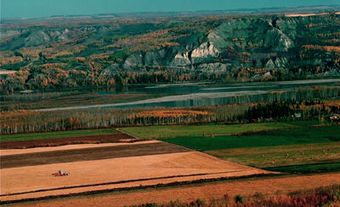
Tantramar marsh's complex system of bogs, rivers, lakes and marshes once provided a habitat for thousands of waterfowl. However, the building of dikes to reclaim the land for farming, which the Acadians began in the 1670s, drained more than 90 per cent of the Chignecto marshes by the early 1900s. At that time the nutrient-rich silt deposited by Bay of Fundy tides supported a lucrative haying industry and the region came to be called "the world's largest hayfield." The hay market declined with the subsequent growth of the automobile industry, however, and the dikeland gradually fell into disrepair. In recent years, hundreds of hectares of marshland are being reclaimed for waterfowl by federal, provincial and private concerns. The largest project, conducted by the Canadian Wildlife Service, involves restoration of a suitable wildlife habitat on 1,990 ha in the Tintamarre National Wildlife Area on the upper reaches of the Tantramar river. The present-day marshes are among the densest breeding grounds in the world for some species, such as the marsh hawk (or northern harrier), and support small industries in muskrat and wild rice. The name derives from the French tintamarre ("din"), referring to the noise of the rushing tide in the river or of flocks of wild geese in the marshes. (See also Wetlands).

 Share on Facebook
Share on Facebook Share on X
Share on X Share by Email
Share by Email Share on Google Classroom
Share on Google Classroom

